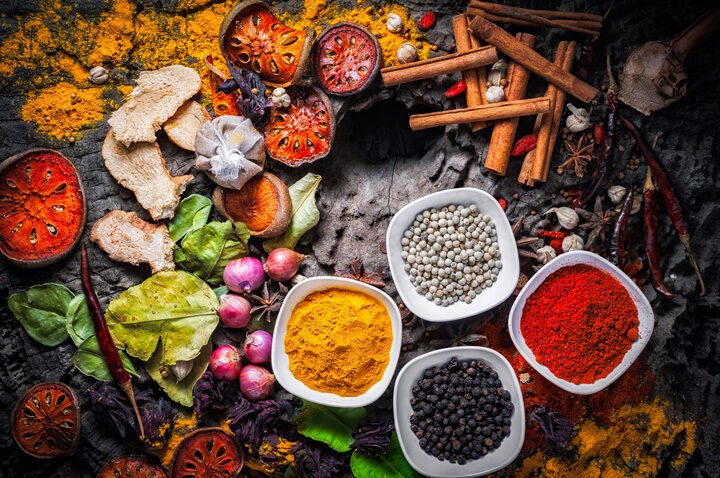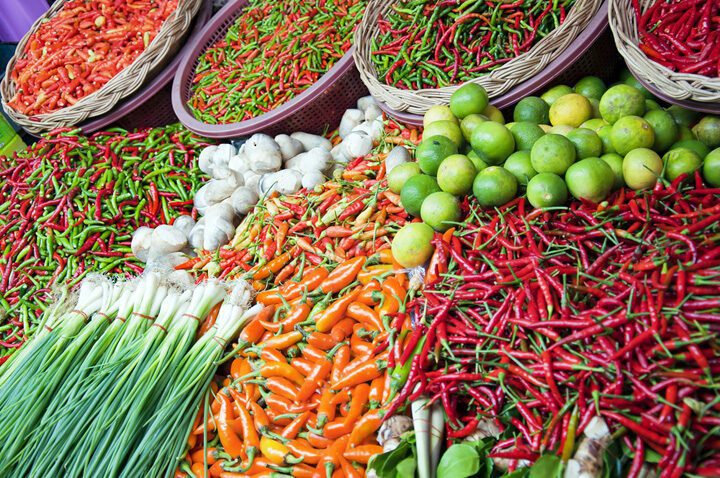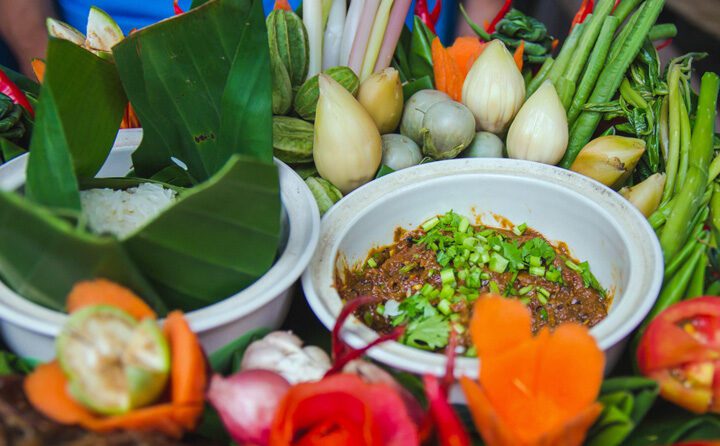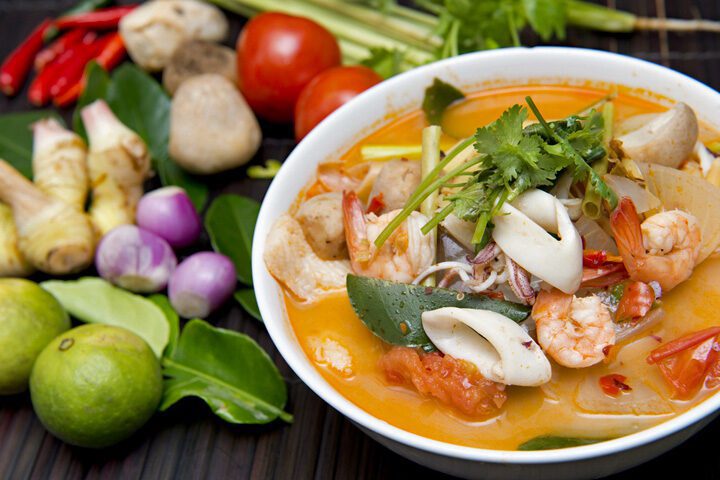The history of Thai cuisine
Until 1939, the country we now call Thailand was known as Siam. It was the only Southeast Asian country never to have been colonized by a Western country, which allowed it to cultivate its eating habits with its own special dishes. But that does not mean that Thailand was not influenced by its Asian neighbors.
Chinese origin
What we now call Thai people are largely descendants of migrants from southern China who moved south about 2000 years ago. They brought with them the cooking skills of their own Yunnan province, including the main ingredient, rice. Other Chinese influences on the Thai cuisine are the use of noodles, dumplings, soy sauce and other soy products. One can speak of Chinese heritage, that Thai dishes are based on five fundamental tastes: salty, sweet, sour, bitter and hot.
From nearby India came not only Buddhism, but also fragrant spices such as cumin, cardamom and coriander, as well as curry dishes. The Malays from the south brought other spices to this country as well as their love for coconuts and satay.
The influence of foreign trade through the 'Silk Road' and various sea routes on Thai food was significant, as these trade routes, with the spice trade in the lead, connected Asia to Europe and vice versa. In the end, a large number of European countries, including Great Britain, France and Holland also had major economic interests in Asia as a direct result of the spice trade. These interests were protected with a military presence, but Thailand was the exception to the European rule.
Foreign influence
Traditional Thai cooking methods were stewing, baking or grilling, but Chinese influences also introduced stir-frying and deep-frying.
In the 17th century, Portuguese, Dutch, French and Japanese influences were also added. Chili peppers, for example, now an important part of Thai cuisine, were brought to Thailand from South America by Portuguese missionaries in the late 1600s.
Thais were good at using these foreign cooking styles and ingredients, which they mixed with their own methods. Where necessary, foreign ingredients were replaced by local products. The ghee used in Indian cooking was replaced by coconut oil and coconut milk was a perfect alternative to other dairy products. Pure spices, which overpowered the taste, were weakened by adding fresh herbs, such as lemongrass and galangal. Over time, fewer spices were used in Thai curry, with more fresh herbs being used instead. It is well known that a Thai curry can be quite hot, but only for a short period of time, while that "hot" taste of Indian and other curries with strong spices lingers longer.
Variants
Thai food has different varieties depending on the region. The food in each of these regions was influenced by its neighbours, residents and visitors, while also evolving over time by constantly adapting to local conditions. The northeastern part of Thailand was heavily influenced by the Khmer from the area now known as Cambodia. The Burmese influenced the north of Thailand, but the Chinese influence is also noticeable there, albeit to a lesser extent. In the southern region, Malay cuisine had a major impact on the food, while Central Thailand was influenced by the 'Royal Cuisine' of the Ayutthaya Kingdom.
The Isan
The area in the northeast of Thailand, called the Isan, has a lot of influence from Khmer and Lao cuisine in terms of eating habits. It is the poorest region of Thailand and that is also reflected in the food. Anything edible is used, think of insects, lizards, snakes and all parts of the pig. A chicken is also used in its entirety, including the head and the lower part of the leg (the foot). It is made with the addition of various herbs and spices and is a popular soup dish. People from Isan have migrated to other parts of the country for better job opportunities, so their food can be found all over Thailand.
South
The southern provinces of Thailand still have a heavy influence from Malaysia. In this part of Thailand you will find a majority of Thailand's Muslim population. As a result, the food in this part of Thailand is very similar to the food in Malaysia, but with a unique Thai flavor due to the combination of herbs and spices. Also, the former ties to Persian cuisine and foods and those of other Middle Eastern countries are evident in the diets of the southern Thai provinces.
royal cuisine
The preparation of food in the central provinces, dating back to the Royal Cuisine of the Ayutthaya Kingdom, is a more refined version of the Thai food in other provinces. It is also the style of Thai food, mostly found in Thai restaurants in the West. You will also find it on the menu in most four and five star restaurants in Thailand. It is unlikely that you will find chicken feet or pork intestines in the soup in these restaurants.
Tourism
Due to the growth of Thailand as a tourist and expat hotspot, more and more international restaurants are opening up and you will find Western products in the supermarkets. However, it is not only the farangs (Westerners) who adhere to the Western style of food, but also more and more Thais are surrendering to foreign food. Western restaurants employ Thai chefs to assist in the preparation of Western foods, meaning that the styles of cooking and familiarity with the ingredients are passed on to the locals.
Thai food was influenced by other cultures over the years and is still evolving. Hopefully not with a negative effect, because it would be a pity if Thai food in Thai restaurant were too much adapted to suit western tastes. Thai food lovers can only hope that real Thai food will never lose its unique taste of sweet, sour, bitter, salty.
Source: Rosanne Turner on the Samui Holiday website






Too bad the "Western lifestyle" is rather bad, especially the fast food.
Unlike Asian cuisine which is much healthier.
Another aspect that can be mentioned briefly.
Whether Asian cuisine in general is now so much healthier? I question that, judging by what I see what is being worked in by many.
Dutch cuisine, French cuisine, Chinese cuisine, Indian cuisine. All originally very healthy, originally!! And then fast food came into play…. Calories, fats, sugars, carbohydrates and to a lesser extent starches and "additives". And that too in excess. That's where it goes wrong.
Just some vegetables, pasta/rice/potatoes and meat. That with some balanced herbs. Without salts and sugars. It can't be healthier. The carbohydrates (pasta / rice / potatoes) to a limited extent, and the meat to a very limited extent and you eat super healthy.
Thai cuisine becomes "depraved" due to the added palm sugars.
And in addition, Thailand has also discovered the convenience of fast food, just like Europe has discovered since the 70s, and the US several years earlier.
We believe Americans have been fat since the 80s, Europeans have been since the 90s, and Thais have been increasingly so since the 00s….
We call that progress. (i.e. wealth and laziness)
“Thai dishes are based on five fundamental tastes: salty, sweet, sour, bitter and hot”.
Correction I think; warm (or hot/spicy/spicy) is not a taste.
The 5th taste is umami…..
And the great trick of Thai cuisine is the perfect balance in these 5 flavors.